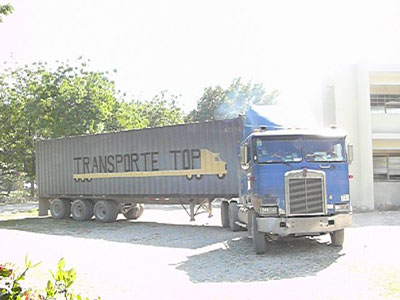Cooking for 14,000 children

Cooking for 14,000 children
When the truck with the blue SOS Children's Villages logo arrives in the neighborhood of Centre Butter Boyer 1 on the outskirts of the Haitian capital Port-au-Prince, it's time for Violeta to organise the unloading of food items.
"It's always a bit exciting to see what's coming," the 37-year old mother of two says. This particular day the SOS team is bringing a load of soybean oil, salt, rice and beans. There are also some boxes of high nutrient biscuits. Occasionally the boxes and bags might also be full rice, spaghetti and bottled water or consist of cans with sardines or tuna. When the stock has been unloaded, a small army of helping hands from the local community will carry the goods to Violeta's storage room, just a minute away from the drop-off point. Right beside the small, cool room is a long row of low tables. This is where 120 children in the age of two to ten years will be eating their daily home-cooked meal. Already a group of younger children sit and wait on small chairs for the meal to be ready. A woman keeps them occupied with songs and clapping games.
This day, three women are busy steaming and stirring the food in large pots as the new load arrives. Steamed rice beans will soon land in front of the children. "This is a very good way of ensuring a meal for all the small ones," Violeta says. Many more people like Violeta are on the lookout for that special white pick up with food donations and the SOS stickers on the side. A total of 88 food distribution points are currently receiving food donations from SOS Children's Villages, reaching approximately 14,000 children. The community meets up and cooks and shares the donated food among the children. If SOS teams are there, there is the opportunity for individual attention and conversations, and if a child is in need of medical care, SOS Children's Villages sees to it that he or she receives it.
Before the earthquake, SOS Children's Villages provided family assistance via 16 community centres. After the earthquake in January, the number has steadily increased to the present 88. When the SOS Children's Villages emergency aid programme has reached its full extent in the coming weeks, there will be around 266 centres, providing around 40,000 children with basic supplies. Every one of these centres has its own committee, which guarantees that the food delivery is used appropriately and that the children receive enough food every day.
The committee will also have to organise storage as well as proper hygienic cooking facilities and keeps detailed records with the data of all the children (name, address, age, family status).Through this networking and shared responsibility between community committees and SOS Children's Villages, it is also possible to identify those children who are particularly in need of help and admit those especially vulnerable children to the temporary care programme in the SOS Children's Village in Santo.

 Return to Schools Wikipedia Home page…
Return to Schools Wikipedia Home page…
